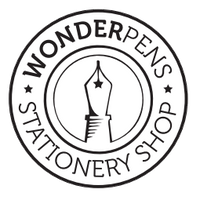Yamamoto Papers Part III: Lightweights
Here are the last of the writing samples and descriptions for the Yamamoto Papers that we received in from Japan. You can find all of the Yamamoto Papers on the website here.
This last instalment covers the four lightest, thinnest papers. These are uniformly quite crinkly and wrinkle easily. They are also slightly translucent, being so thin.
***
Bank Paper was developed by Mitsubishi Paper Mills in 1960 for use as bank ledger paper. It was developed to provide a smooth writing experience using a broad range of writing instruments, along with durability for use in an office environment. The ingredients of Bank Paper is a unique blend of several types of pulp and cotton, developed specifically to prevent any see-through and consistent texture for dual-sided use. The "Three Diamonds" watermark is Mitsubishi Paper Mills stamp of assurance for their high quality manufacturing. Our fountain pen tests showed quick dry times, accurate color reproduction, and no bleed-through.
***
The opaqueness of paper comes from the air pockets between the pulp fibers. It is the random reflection of the light that creates the white appearance of paper. To give paper greater transparency, one must reduce the space between the pulp fibers. When creating glassine paper, you must grind the pulp much more thoroughly than regular paper. On top of that, extreme pressure is applied to the paper using a super calender to further reduce space between the fiber, producing a very dense paper with high transparency. Our fountain pen ink tests showed longer than average dry times, but resulted in great color reproduction and no bleed-through.
Glassine paper is lovely for crafting, wrapping, journaling, and its strength means that you can crinkle it and unwrap to get texture onto it. I found that fountain pen ink on it will vary widely, and some ink does better than others in terms of bleeding. Various kinds of markers and fineliners tended to do better but dry times were long as glassine paper is a bit glossy.
***
It is important for Typewriter Paper for copy with carbon paper to be thin and durable. Genta Yoshii (1826-1908) is known as the father of modern Japanese thin paper making. The Typewriter Paper for copy he developed in the early 1900s was very popular in America. Mitsubishi Paper Mills Typewriter Paper was also developed to handle the strong strikes from the typewriter keys while still being thin. You are able to stack five sheets of this paper with carbon copy sheets in-between in a typewriter and still get crisp letters on all sheets. It handles ink well and has good printing qualities. Our fountain pen tests showed short dry times, good color representation, and no bleed-through. This paper is produced using old equipment at the Takasago factory in Hyogo prefecture. It has the level of quality that would be difficult be reproduce using modern mass-production equipment.
This paper is another lovely, very thin paper. It’s thin enough to almost be translucent, although not quite as translucent as tracing paper. Lots of crinkling. Fountain pen ink on it looks terrific, very crisp lines.
***
Diazo copying (blueprinting) is a printing process where the original document and photosensitive paper is pressed together, upon which light is shined through to burn the text onto the photosensitive paper. Very thin paper is needed for this process. However, the thinner the paper, the less durable the paper becomes and becomes difficult to handle. Mitsubishi Paper Mills Champion Copy was developed to produce a paper that is durable but has high see-through. It also offers high printability for letterpress and offset-printing. Our fountain pen tests showed fast dry times, good color reproduction, and no bleed-through. This paper is made using old equipment at the Takasago factory in Hyogo prefecture.
Another thin and crinkly paper, slightly less thin than the Typewriter Paper. Another one that is great for fountain pen ink, with sharp lines.
***
I hope you enjoyed the overview of the new papers. It’s always fun to get some new stationery, whether for correspondence, printing something special, to test out new inks and fountain pens on.
It was a labour of love and also a little meditative to organize the papers, do the writing samples and take the photos. I had procrastinated a bit on it, and left it too long so I had to spend more time than I probably otherwise needed to sort out my photos, which is basically my life, organizing disorganized things while I go slightly mad. Chipping away at the to do list, in any case.



